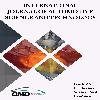Investigation of Polymer Matrix Composites in Automotive Consoles
Investigation of Polymer Matrix Composites in Automotive Consoles
Research on reducing the weights of automobiles, achieving fuel consumption and reducing harmful exhaust emissions focuses on the investigation of new materials. Polymer matrix is the most commonly used material with respect to composite applications within the scope of abovementioned research domain. Since polymer materials are inexpensive and have improved physical and mechanical properties, they are used as a substitution to metallic materials in several applications. The front barrier of a car made of glass fiber-reinforced polymer composite is capable of succeeding a crash test of 35-mph. Besides providing a similar level of crash security as steel, polymer composites are also capable of providing improved performance with features such as vibration control. The use of polymer materials in the interior and exterior design of automobiles increases each day. Polymer materials are preferred for various car parts, such as consoles, door baffle boards, floor mats, air conditioning pipes and grids etc. The present study focuses on the analysis of the mechanical properties of polypropylene used in front consoles of the vehicles. In this respect, front consoles of various automobile models, which were made of polypropylene, were analyzed.
Keywords:
Console, polypropylene plastic, composite, tensile strength,
___
- [1] Thakur, V.K., Thakur, M.K., Gupta, R.K. (2014). Review: raw natural fiber-based polymer composites. Int. J. Polym. Anal. Charact, 19, 256-271.[2] Ku, H., Wang, H., Pattarachaiyakoop, N., Trada, M. (2011). A review on the tensile properties of natural fiber reinforced polymer composites. Compos. Part B Eng, 42, 856-873.[3] Barari, B., Ellingham, T., Qamhia, I., Pillai, K., El-Hajjar, R., Turng, T. et al. (2016). Mechanical characterization of scalable cellulose nano-fiber based composites made using liquid composite molding process. Compos. Part B Eng 277-284.[4] Unterweger, C., Brüggemann, O., Fürst, C. (2014). Synthetic fibers and thermoplastic short-fiber-reinforced polymers: properties and characterization. Polym. Compos, 35, 227-236.[5] Santos, T., Vasconcelos, G., Souza, W., Costa, M., Botelho, E. (2015). Suitability of carbon fiber-reinforced polymers as power cable cores: Galvanic corrosion and thermal stability evaluation. Mater Design, 65, 780-788.[6] Pei, X-Q., Bennewitz, R., Schlarb, A.K. (2015). Mechanisms of friction and wear reduction by carbon fiber reinforcement of Peek. Tribol Lett, 58, 1-10.[7] Bahadur, S., Zheng Y. (1990). Mechanical and tribological behavior of polyester reinforced with short glass fibers. Wear, 137, 251-266.[8] Zhang, S. (1998) State-of-the-art of polymer tribology Tribol. Int 31, 49-60.[9] Zhang, Y., Zhu, S., Liu, Y., Yang, B., Wang, X. (2015). The mechanical and tribological properties of nitric acid-treated carbon fiber-reinforced polyoxymethylene composites J. Appl. Polym. Sci, 132.[10] Herrera-Franco, P.J. and Valadez-Gonza´lez, A. (2004). Mechanical properties of continuous natural fibre-reinforced polymer composites. Composites Part A 35, 339–345.[11] Selzer R. and Friedrich K. (1997). Mechanical properties and failure behaviour of carbon fibre-reinforced polymer composites under the influence of moisture, Composites Part A 28A, 595- 604.[12] Faris M. AL-Oqla, Sapuan, S.M. (2014). Natural fiber reinforced polymer composites in industrial applications: feasibility of date palm fibers for sustainable automotive industry. Journal of Cleaner Production 66, 347-354.[13] Phetphaisita, C. W., Namahoota, J., Saengkiettiyutb, K., Ruamcharoenc, J. (2015). Polphat Ruamcharoen Green metal organic coating from recycled PETs and modified naturalrubber for the automobile industry. Progress in Organic Coatings 86, 181–189. [14] Ku, H., Wang, H., Pattarachaiyakoop, N., Trada, M. (2011). A review on the tensile properties of natural fiber reinforced polymer composites, Composites: Part B 42, 856–873.[15] Miao, C. and Hamad, W.Y. (2013). Cellulose reinforced polymer composites and nanocomposites: a critical review, Cellulose, 20:2221–2262.[16] Saffet, G (2018-Ocak). Otomotiv Endüstrisinde Kullanılan Polimer Matrisli Kompozit Malzemeler, Yüksek Lisans Tezi, Pamukkale Üniversitesi, Fen Bilimleri Enstitüsü.[17] Muhammad Hanafi Md S. (2017). Mechanical Properties of Coconut Shell Powder Reinforced PVC Composites in Automotive Applications, Journal of Mechanical Engineering, Vol 14(2), 49-61.[18] Savaşçı, Ö.T., Uyanık, N., Akovalı, G. (1999). Plastikler ve Plastik Teknolojisi, PAGEV Yayınları, İstanbul.
- Yayın Aralığı: Yılda 4 Sayı
- Başlangıç: 2016
- Yayıncı: Otomotiv Mühendisleri Derneği
